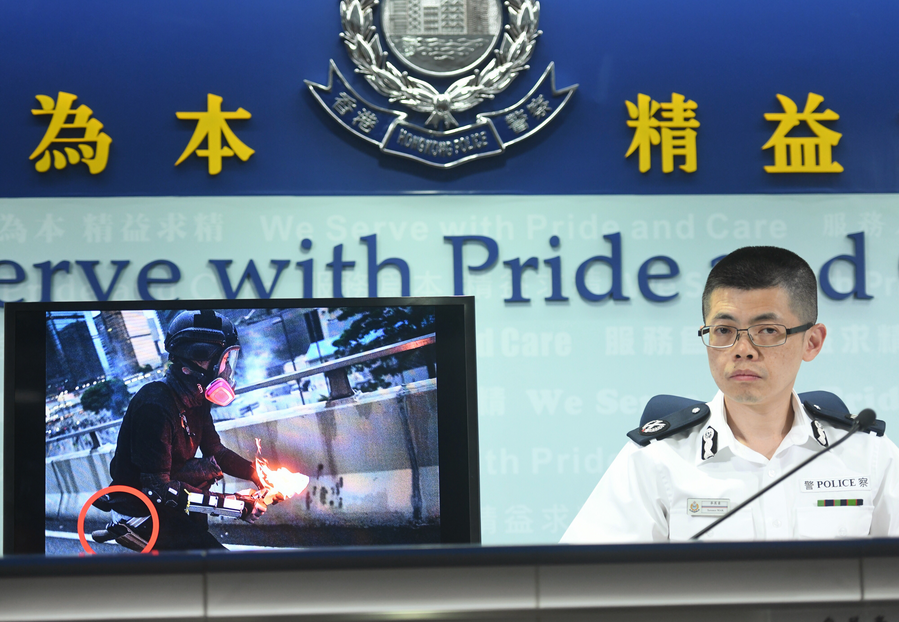
Rioters set fires at Causeway Bay, one of Hong Kong's busiest commercial districts, on Aug. 31. (Xinhua)
Coupled with prolonged protests and violence in Hong Kong, the lies and slanders against the Hong Kong police and the HKSAR government have been fueling the already intense situation, providing excuses for more violence. Chief Executive Carrie Lam urges the public to carefully discern the information they receive.
HONG KONG, Sept. 12 (Xinhua) -- Persistent rumors and fake news have exacerbated social tensions and whipped up violent activities in Hong Kong over the past three months.
Much of the misinformation has been used by radical protesters as pretexts to resort to more violence, slander police and government authorities, and stoke hatred.
Here are some of the fake news and what's really happening as verified by Hong Kong police force and news media:
1.FAKE NEWS: "MTR Death"
The opposition and radicals claimed there was a protester death at Prince Edward MTR station on Aug. 31. Taking this as an excuse, radical protesters surrounded and attacked the Mong Kok police station, and even attempted to set up a "mourning hall" at the MTR station.

Mak Chin-ho, assistant commissioner of police, refutes rumors about the protester death, at a press conference on Sept. 2. (Xinhua)
The TRUTH: Neither Mong Kok Police Station nor the police missing persons unit had received any report of missing persons in connection with the incident on Aug. 31, according to a joint press conference by the police, hospital authority and fire department.
A total of 53 people were arrested at Prince Edward MTR station on the night of Aug. 31, including seven people who needed to be sent to hospitals for treatment.
2. FAKE NEWS:"Police use petrol bombs"
During a protest at Tsuen Wan on Aug. 25, some violent protesters hurled petrol bombs at the police. CNN released a story headlined "Police use petrol bombs and water cannons against Hong Kong protesters," citing a widely circulated tampered video.
THE TRUTH: CNN later apologized for its "erroneous" headline and replaced it with a correct one.
3.FAKE NEWS:"Police disguise as protesters"

Hong Kong police warn protesters over carrying guns at a press conference on Sept. 2. (Xinhua)
In a broadly circulated photo, a rioter carrying a gun on his waist was throwing a petrol bomb at the police on Aug. 31. The picture was used by the opposition as an "evidence" of police personnel disguise as protesters.
THE TRUTH: The guns carried by protesters were not used by the police.
4.FAKE NEWS:"Hitting non-protesters"
A photo of a police officer "hitting" non-protesters with his shield had been widely used as proof of police brutality.
THE TRUTH: Video footage later revealed that the officer was holding his shield up to protect passersby as he escorted them out of the danger zone.
5.FAKE NEWS:"Strip-search"
The opposition hyped up another incident that a female police officer had strip-searched a female protester for 15 to 30 minutes.
THE TRUTH: The Hong Kong police then clarified that they checked related documents and the CCTV record, and found that the level of the search was not the "3C" level which requires a strip search; the whole search took four minutes.
6.FAKE NEWS:"Smart lamppost monitoring protesters"

Radical protesters pull down a smart lamppost in Kowloon Bay, Hong Kong on Aug. 24, 2019. (Xinhua)
The opposition can be very "creative" in smearing the Hong Kong police and the Hong Kong Special Administrative Region (HKSAR) government, including the "smart lamppost" conspiracy, in which the lampposts installed to collect air, traffic and weather data were said to "monitor" protesters.
THE TRUTH: The cameras of the lampposts are set to face public areas only and do not carry any facial recognition function.
Rioters nevertheless took down one lamppost and damaged 19 others. The total repair fees amounted to 2.8 million Hong Kong dollars (about 360,000 U.S. dollars).
The increasing number of negative, violent and fake information has exacerbated social tensions, said Yip Siu Fai, a professor at the University of Hong Kong.
Hong Kong police authorities have launched ten anti-violence hotlines to collect information, including photos, audio and video clips via WhatsApp to assist in the prevention and detection of possible crimes.
At a press conference Tuesday, HKSAR Chief Executive Carrie Lam urged the public to carefully discern the information they received.
The HKSAR government will try its best to provide a timely account of information and facts, Lam said, adding that a special section has been set up on the government's website to clarify rumors at a timely manner.



